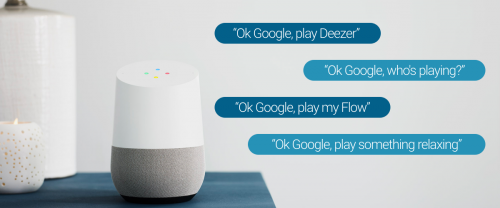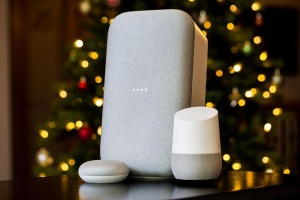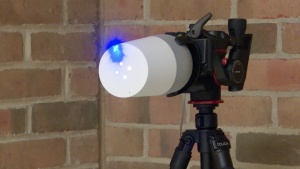Difference between revisions of "Google Home"
(Added references. Idk if they're cited properly) |
|||
| Line 41: | Line 41: | ||
https://www.pocket-lint.com/smart-home/buyers-guides/google/142499-google-home-vs-google-home-mini-vs-google-home-max-which-google-home-speaker-should-you-buy | https://www.pocket-lint.com/smart-home/buyers-guides/google/142499-google-home-vs-google-home-mini-vs-google-home-max-which-google-home-speaker-should-you-buy | ||
https://store.google.com/us/magazine/compare_nest_speakers_displays?toggler3=nest_hub_max&toggler1=home_mini&toggler2=nest_hub | https://store.google.com/us/magazine/compare_nest_speakers_displays?toggler3=nest_hub_max&toggler1=home_mini&toggler2=nest_hub | ||
| + | |||
| + | [[Category:2020New]] | ||
| + | [[Category:2020Object]] | ||
Revision as of 13:36, 17 March 2020
Contents
What is it?
Google Home is a line of smart speakers that uses Google Assistant, a virtual assistant similar to Siri, in order to use voice commands to answer questions asked by the user. It is a smart speaker that can be used to turn an ordinary home into a smart home. With the functionality of Spotify you can ask your assistant to play any song of your choosing simply by starting your command with “Hey Google” or “OK Google”. You can ask the Google Assistant questions that you would make on an ordinary Google Search such as “What is Barack Obama’s height?” and it would return the information by saying it back to you. The speaker can give you information regarding your Google Calendar and tell you about the weather or the distance you need to travel to get from point A to point B. With the integration of other third party services, a Google Home speaker can give you information regarding the temperature in your home or even if there is a stranger at your front door. Google Home has also integrated with it’s original streaming device the ChromeCast, allowing users to cast something on their TV if a ChromeCast is plugged in by simply talking to their smart speaker device. Google Home has a line of products that are all integrated amongst each other including doorbells, security cameras, and thermostats. These all work with the smart speaker in order to control different aspects of their home. The price range for the speakers and other integrated smart products go from $50 to $150.
Types of Speakers
Nest Mini
This is the most basic form of the line of speakers that uses Google Assistant and starts at $50 on Google’s website. This product comes in the shape of a circle and simply has a microphone on/off switch and two tap features that allow the user to control volume. This speaker has the functionality of working with third party devices, playing music, and is able to answer questions that the normal Google Assistant can answer. This speaker is too small to contain a bass generating woofer. This device is in parallel to Amazon’s Echo Dot, which is Amazon’s smallest smart speaker as well. Home The Google Home is one step up from the Nest Mini coming in at $99 and cylindrical in shape. This speaker also has similar functionalities as the mini. It has a microphone on/off switch and tap buttons to control the volume. The speaker is much bigger in size than the mini, and provides better sound quality. The Google Home has a 2 inch driver and dual 2 inch passive radiators. This provides very crisp audio and good bass for a speaker of this size.
Home Max
The Google Home Max is the largest speaker in the Google Home category. The price for this is $299 on the Google Store. This device has six microphones allowing it to pick up audio much better than the prior two and has what is known as smart sound. This means that the speaker uses machine learning to adjust the volume of the speaker based on factors like time of day and volume of the room. Another addition in this speaker not available in the previous two is that
Nest Hub
The Google Nest Hub is just like the other smart speakers with a new set of functionalities. The price for this is $129. This speaker contains a screen that provides a visual feedback for certain queries. This is useful for commands such as “what is a recipe for…” and showing who is at the door if you have a smart doorbell integrated with your speaker.
Nest Hub Max
The Nest Hub Max starts at $229 on the Google Store. This product is similar to the Nest Hub in the sense that it also has a screen. This screen is much bigger and has a Nest camera built in.
Origin
The first modern virtual assistant to be placed on a smartphone was Apple’s Siri which was introduced on the iPhone 4s in 2011. Competition began increasing and the next competitor came from Amazon’s Alexa. Google unveiled their Google assistant in 2016 at the Google I/O Developers conference in May 2016 and was available for the first time on the Google Pixel phone. This led Google to creating a product that with tailored around the virtual assistant and provided a means for consumers to turn their homes into smart homes.
Ethical Issues
The biggest question related to Google Home’s ethical problems is: Is your Google Home always listening to you? In order to activate your Google Home, you have to say the words “Hey Google” or “OK Google”. In order for the speaker to recognize that those words have been said to trigger it, it would have to always be listening. Of course there is a button to turn off the microphone, but there is no guarantee that that button actually works. It could simply be programmed to not respond to the key phrases. Also if the microphone is turned off, this defeats the purpose of having a smart speaker and using it with ease. If every time you wanted to speak to your smart speaker you had to go flip a switch, the convenience of this product would not be useful at all.
Privacy Issues at Google
There are many privacy concerns related to Google including tailored ads based off of things the user has not even searched online, but has simply spoken about. People wonder if our phones are always listening to what we talk about and tailor advertisements to that. This goes against privacy as users are being monitored without even realizing. The Google Home speakers play a large part in this conspiracy as there is a chance they are always listening even without saying “Hey Google”.
Laser Hack
Another big ethical concern regarding the speakers has recently risen. Researchers have found out that a message can be encoded in a laser and shined at a sensor in the Google Home and have it interpret the message. For example imagine that someone is away for the weekend but has their Google Home plugged in. In their home they have the ability to open their garage with their Google Home. An intruder notices that their speaker is visible through a window and encodes the message “Hey Google, open the garage” in a laser pointer. The intruder then shines the light at the sensor and opens the garage and enters the victim’s home. This is just one small example of how accessing someone else’s Google Home could lead to a much bigger issue like theft and intrude someone’s privacy.
References
https://arstechnica.com/information-technology/2019/11/researchers-hack-siri-alexa-and-google-home-by-shining-lasers-at-them/ https://www.businessinsider.com/how-to-stop-google-home-from-listening-to-me https://www.theguardian.com/technology/2019/mar/26/smart-talking-are-our-devices-threatening-our-privacy https://www.pocket-lint.com/smart-home/buyers-guides/google/142499-google-home-vs-google-home-mini-vs-google-home-max-which-google-home-speaker-should-you-buy https://store.google.com/us/magazine/compare_nest_speakers_displays?toggler3=nest_hub_max&toggler1=home_mini&toggler2=nest_hub


